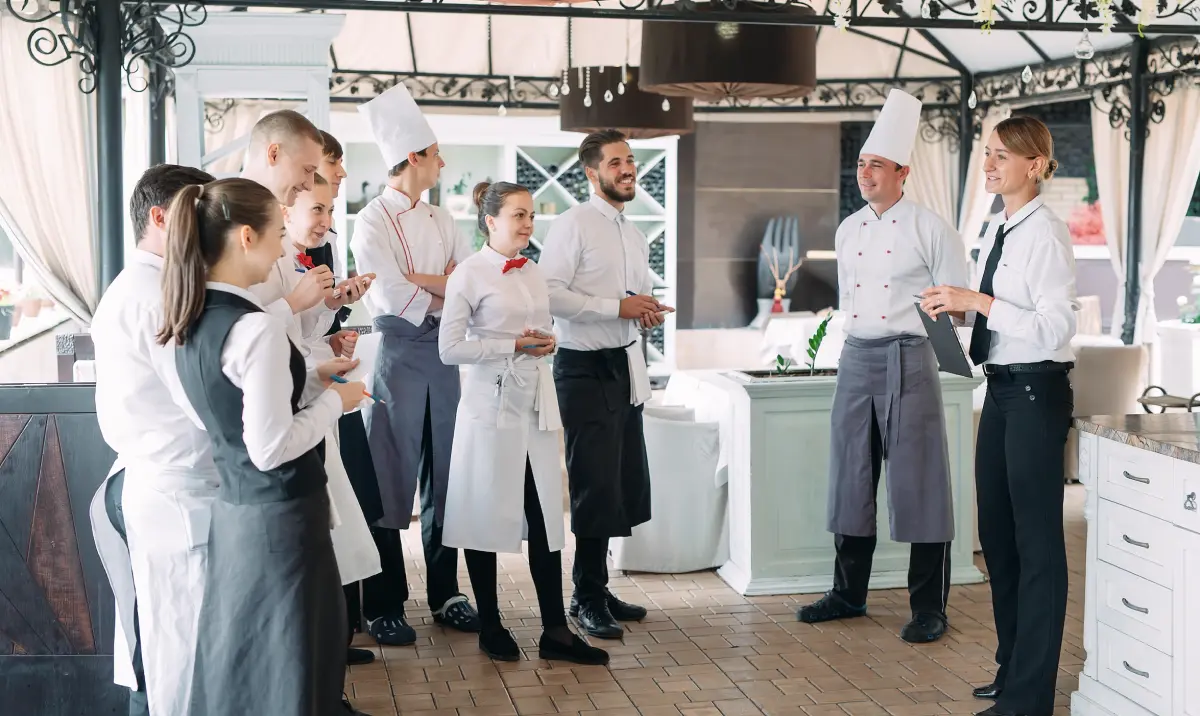

Restaurant Management: 15 Pro Tips & Strategies for Success
Running a successful restaurant involves more than just serving delicious food; it’s about managing multiple moving parts efficiently and strategically. From staffing and finances to customer satisfaction and marketing, restaurant management requires a blend of business acumen, leadership skills, and creativity.
Whether you’re a seasoned restaurateur or just starting out, mastering the art of management is essential for sustainability and growth in this competitive industry. Effective restaurant management not only improves your bottom line but also creates a memorable experience for your guests, turning first-time diners into loyal customers.
In this guide, we’ll explore 15 expert tips and strategies designed to help you manage your restaurant with confidence. These actionable insights will cover every aspect of your business, ensuring you’re equipped to tackle challenges, optimize operations, and exceed expectations. Let’s dive in!
Building a Strong Foundation
A strong foundation is the cornerstone of any successful restaurant. It begins with a clear vision, a well-crafted business plan, and adherence to legal requirements. These essential elements not only guide your operations but also set the tone for your brand and long-term success.
Define Your Restaurant’s Vision and Mission
Your vision and mission are the heart of your restaurant. They provide direction and define what sets your business apart from competitors.
How to craft your vision and mission:
- Identify your core values: What principles do you want your restaurant to embody?
- Clarify your target audience: Who are your ideal customers, and what do they value?
- Focus on uniqueness: What makes your restaurant stand out in the market?
Example of a mission statement:
“To provide a cozy dining experience where families can enjoy authentic Italian cuisine made with fresh, locally-sourced ingredients.”
A clear mission statement ensures consistency in your operations and marketing while keeping your team aligned with your goals.
Create a Detailed Business Plan
A well-structured business plan serves as a roadmap for your restaurant’s success. It not only guides your decision-making but is also essential when seeking investors or loans.
Key components of a restaurant business plan:
- Executive summary: A brief overview of your restaurant’s concept and goals.
- Market analysis: Insights into industry trends and your competition.
- Financial projections: Detailed revenue and expense estimates for the first 3-5 years.
- Marketing strategy: How you plan to attract and retain customers.
- Operational plan: Details on staffing, suppliers, and logistics.
By revisiting and updating your business plan regularly, you ensure your restaurant stays on track and adapts to market changes.
Secure the Right Licenses and Permits
Operating without proper licenses and permits can result in hefty fines or even closure. Ensuring compliance from the start protects your investment and builds customer trust.
Licenses and permits to consider:
- Business license: To legally operate your restaurant.
- Food service license: For health and safety compliance.
- Liquor license (if applicable): For serving alcohol.
- Signage permits: For outdoor advertising and branding.
- Fire safety certificate: To meet safety standards.
Tips for successful applications:
- Research the specific requirements in your city or state.
- Submit all documentation accurately and on time.
- Maintain open communication with local authorities.
Getting your licenses and permits in order sets the stage for a smooth and legally compliant operation.
Effective Financial Management
Managing finances effectively is crucial for any restaurant’s sustainability and profitability. With tight margins in the industry, keeping track of income, expenses, and overall financial health is essential. By establishing strong financial practices, you can make informed decisions and steer your restaurant toward long-term success.
Budgeting for Profitability
Creating and sticking to a budget ensures your restaurant operates within its financial means. It helps you allocate resources wisely and avoid unexpected financial crises.
Steps to create a realistic budget:
- List all income sources: Include revenue from dine-in, delivery, catering, or events.
- Track fixed costs: Rent, salaries, utilities, and insurance.
- Account for variable expenses: Food, beverages, marketing, and maintenance.
- Set aside for contingencies: A reserve fund for emergencies.
Regularly reviewing your budget and comparing it with actual performance allows you to identify areas of improvement and ensure profitability.
Monitor Key Financial Metrics
Understanding and monitoring financial metrics can give you valuable insights into your restaurant’s health. Key metrics allow you to pinpoint inefficiencies and adjust operations accordingly.
Important financial metrics to track:
- Prime cost: The combined cost of food, beverages, and labor, ideally kept under 60-65% of revenue.
- Food cost percentage: Helps evaluate the profitability of your menu items.
- Cash flow: Tracks the money moving in and out of your business to ensure liquidity.
- Break-even point: Determines the minimum revenue needed to cover expenses.
Monitoring these metrics consistently can help you make data-driven decisions and improve financial performance.
Optimize Inventory Management
Effective inventory management reduces waste, controls costs, and ensures you always have the ingredients you need.
Best practices for inventory management:
- Track inventory levels: Use software to monitor stock in real-time.
- Follow the FIFO method: First-In-First-Out to avoid spoilage.
- Conduct regular audits: Compare actual inventory with recorded numbers to identify discrepancies.
- Streamline vendor relationships: Negotiate better pricing and establish reliable supply chains.
Optimized inventory management not only boosts profitability but also ensures a consistent dining experience for your customers.
Staff Management and Team Building
Your staff is the backbone of your restaurant, and effective management can make or break your business. By hiring the right talent, providing ongoing training, and fostering a positive work environment, you can build a motivated team that delivers exceptional service and drives success.
Hire the Right Talent
Hiring the right people is critical to creating a team that aligns with your restaurant’s vision and values. Prioritize skills, attitude, and cultural fit to ensure your staff contributes to a harmonious workplace.
Tips for hiring effectively:
- Define roles clearly: Write detailed job descriptions for each position.
- Look for soft skills: Communication, teamwork, and adaptability are essential in hospitality.
- Use multiple recruitment channels: Job boards, referrals, and industry networks.
- Conduct structured interviews: Use standardized questions to evaluate candidates consistently.
By investing time in the hiring process, you reduce turnover and build a team that adds value to your business.
Train and Develop Your Team
A well-trained team ensures smooth operations and a consistent customer experience. Training should be an ongoing process, not a one-time event.
Effective training practices:
- Onboarding sessions: Introduce new hires to your restaurant’s culture and standards.
- Hands-on training: Teach staff operational skills, such as using POS systems and adhering to health and safety protocols.
- Role-playing exercises: Prepare your team for handling customer interactions and complaints.
- Cross-training opportunities: Equip staff to take on multiple roles for flexibility during peak times.
Regular training empowers employees, boosts morale, and fosters a sense of loyalty to your business.
Foster a Positive Workplace Culture
A positive workplace culture leads to happier employees, lower turnover, and better customer service. It creates an environment where your team feels valued and motivated.
Ways to cultivate a great workplace culture:
- Recognize achievements: Celebrate individual and team successes regularly.
- Promote open communication: Encourage feedback and provide a platform for addressing concerns.
- Offer growth opportunities: Provide pathways for promotions and skill development.
- Organize team-building activities: Foster camaraderie with events like staff outings or celebrations.
When your team feels appreciated and respected, they are more likely to go above and beyond for your customers and your restaurant.
Enhancing Customer Experience
A positive customer experience is crucial to the success of any restaurant. From the moment a guest walks through the door to when they leave, every aspect of their interaction with your business contributes to their overall impression. By focusing on service quality, ambiance, and customer feedback, you can turn first-time visitors into loyal patrons.
Deliver Outstanding Service
Great service is the cornerstone of customer satisfaction. It’s not just about being polite—it’s about exceeding expectations at every step of the dining experience.
Key service elements to focus on:
- Greeting customers warmly: Make a great first impression with a friendly and prompt greeting.
- Efficient order-taking and delivery: Ensure servers are knowledgeable and quick, without rushing guests.
- Anticipate customer needs: Be proactive in refilling drinks, checking on satisfaction, and addressing issues.
- Personalization: Recognize repeat customers and tailor experiences when possible.
Consistently delivering excellent service helps build rapport with customers, creating a memorable dining experience that encourages repeat visits.
Craft a Memorable Ambience
The atmosphere of your restaurant plays a significant role in how customers perceive their experience. From the décor to the music, creating the right mood enhances the overall dining experience.
Tips to enhance your restaurant’s ambiance:
- Design with your brand in mind: Use colors, furniture, and décor that reflect your restaurant’s theme or cuisine.
- Lighting matters: Soft, warm lighting creates an inviting atmosphere, while bright lights may be better for fast-casual or daytime dining.
- Curate background music: Choose music that complements the mood and isn’t too loud or distracting.
- Pay attention to cleanliness: A clean, tidy environment speaks volumes about the quality of your restaurant.
An inviting ambiance makes customers feel comfortable and enhances their experience, encouraging longer visits and positive reviews.
Handle Customer Complaints Gracefully
Handling complaints effectively is an essential part of customer service. How you respond to issues can turn an unhappy customer into a loyal one and improve your reputation.
Steps for managing complaints effectively:
- Listen attentively: Let the customer fully explain the issue without interruption.
- Apologize sincerely: Even if the issue isn’t your fault, show empathy for their experience.
- Take swift action: Offer a solution, whether it’s fixing the issue, offering a replacement, or providing a discount.
- Follow up: After resolving the issue, check in with the customer to ensure satisfaction.
Turning a negative experience into a positive one shows your commitment to customer satisfaction and can lead to improved loyalty and trust.
Marketing Your Restaurant
Effective marketing ensures your restaurant stays visible, attracts new customers, and keeps existing ones coming back. By building a strong online presence, implementing creative loyalty programs, and leveraging delivery platforms, you can reach your target audience and boost your restaurant’s success.
Build a Strong Online Presence
In today’s digital age, a robust online presence is non-negotiable. It’s often the first point of contact potential customers have with your restaurant.
Steps to establish and grow your online presence:
- Create a professional website: Include essential information like your menu, hours, location, and reservation options.
- Leverage social media platforms: Post engaging content on Instagram, Facebook, and TikTok, showcasing dishes, events, and behind-the-scenes moments.
- Encourage online reviews: Ask satisfied customers to leave reviews on platforms like Google and Yelp.
- Utilize SEO: Optimize your website with relevant keywords to rank higher in search results.
An engaging and consistent online presence builds credibility and attracts customers who are searching for dining options in your area.
Implement Loyalty Programs
Loyalty programs are a powerful way to retain customers and encourage repeat visits. They reward customers for their continued support, making them feel valued.
Ideas for creative loyalty programs:
- Point-based rewards: Customers earn points for each visit or purchase that can be redeemed for discounts or freebies.
- Tiered membership levels: Offer escalating benefits based on frequency of visits or spending.
- Exclusive perks: Provide members with early access to special events or new menu items.
- Digital loyalty cards: Use mobile apps or email to track points and rewards, reducing the hassle of physical cards.
Loyalty programs not only increase customer retention but also provide valuable data on customer preferences and behavior.
Partner with Delivery Platforms
Partnering with delivery services expands your reach beyond the restaurant, making your food accessible to a broader audience. However, it’s important to choose the right platforms and balance in-house dining with delivery operations.
How to maximize benefits from delivery platforms:
- Choose the right platform: Research fees, reach, and customer demographics for services like Uber Eats, DoorDash, or Grubhub.
- Optimize your menu for delivery: Focus on dishes that travel well and maintain quality during transport.
- Monitor delivery performance: Ensure food arrives on time and in excellent condition by collaborating closely with the platform.
- Promote your in-house dining: Use delivery packaging to encourage customers to visit your restaurant for a fuller experience.
Strategic partnerships with delivery platforms can increase your revenue and brand awareness without compromising the quality of your in-house service.
Streamlining Operations
Efficient operations are the backbone of a well-run restaurant. By leveraging technology, establishing standard procedures, and regularly evaluating performance, you can minimize errors, save time, and create a seamless experience for both staff and customers.
Leverage Technology for Efficiency
Modern technology can simplify restaurant operations, improve accuracy, and enhance customer satisfaction. By integrating the right tools, you can reduce manual workload and focus on growing your business.
Essential technologies for streamlining operations:
- Point of Sale (POS) systems: For tracking orders, processing payments, and managing inventory.
- Reservation platforms: Tools like OpenTable or Resy to manage bookings and reduce wait times.
- Employee scheduling software: Automate shift scheduling and track attendance with platforms like 7shifts.
- Kitchen display systems (KDS): Digitize order management for faster communication between servers and kitchen staff.
Adopting technology not only streamlines daily tasks but also ensures better data tracking and informed decision-making.
Develop Standard Operating Procedures
Standard Operating Procedures (SOPs) are detailed guidelines that ensure consistency in every aspect of your restaurant’s operations. SOPs help reduce errors, enhance training, and maintain quality standards.
Steps to create effective SOPs:
- Document processes clearly: From food preparation to customer service, write down each step in detail.
- Involve your team: Gather input from employees to ensure procedures are practical and effective.
- Use visual aids: Incorporate charts, diagrams, or videos for easier understanding.
- Regularly update SOPs: Keep them relevant by revisiting and revising based on feedback or operational changes.
With clear and concise SOPs, your team can work more efficiently, and customers will receive a consistent experience every time they visit.
Regularly Evaluate Performance
Continuous evaluation of your restaurant’s performance helps identify areas for improvement and ensure operations are aligned with your goals. Performance reviews should cover customer satisfaction, employee effectiveness, and overall efficiency.
Strategies for performance evaluation:
- Analyze customer feedback: Use online reviews, comment cards, and surveys to gauge satisfaction.
- Track key metrics: Monitor table turnover rates, food preparation times, and labor costs.
- Conduct staff reviews: Provide constructive feedback during regular one-on-one meetings.
- Perform mystery shopper visits: Gain an unbiased perspective on the dining experience.
Ongoing performance evaluations allow you to address problems promptly, capitalize on strengths, and continuously improve your restaurant operations.
Key Takeaways
Effective restaurant management requires a balance of strategic planning, financial oversight, team leadership, and customer-centric operations. By mastering these areas, you can ensure your restaurant thrives in a competitive industry.
Here are the core takeaways from this guide:
- Build a strong foundation: Define your vision, craft a business plan, and secure the necessary licenses to start on the right foot.
- Master financial management: Create budgets, monitor key metrics, and optimize inventory to maintain profitability.
- Focus on your team: Hire the right talent, provide ongoing training, and foster a positive workplace culture to build a motivated staff.
- Enhance customer experience: Deliver exceptional service, create a memorable ambiance, and handle complaints gracefully to keep guests coming back.
- Boost your marketing efforts: Leverage a strong online presence, implement creative loyalty programs, and partner with delivery platforms to reach more customers.
- Streamline operations: Use technology, establish SOPs, and evaluate performance regularly to ensure smooth day-to-day functioning.
By implementing these strategies, you’ll not only improve your restaurant’s efficiency but also create a thriving business that customers and employees love. The key to long-term success lies in continuous improvement and adaptability to industry trends.
ABOUT THE AUTHOR
Erkin Coban
Your Customers Deserve The Best
And we got Menuviel for them.
The fastest and easy-to-use online QR menu with 12+ unique features. Choose Menuviel and elevate your service quality to the next level.
Use free for the first 30 days.

In This Article

Free AI Tools for Restaurants
TRY NOW ➜

Talk to them in their own language
With Menuviel, cater to an international customer base by adding multiple language options to your menus.





